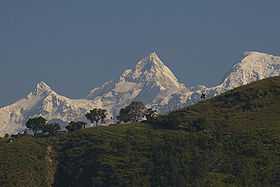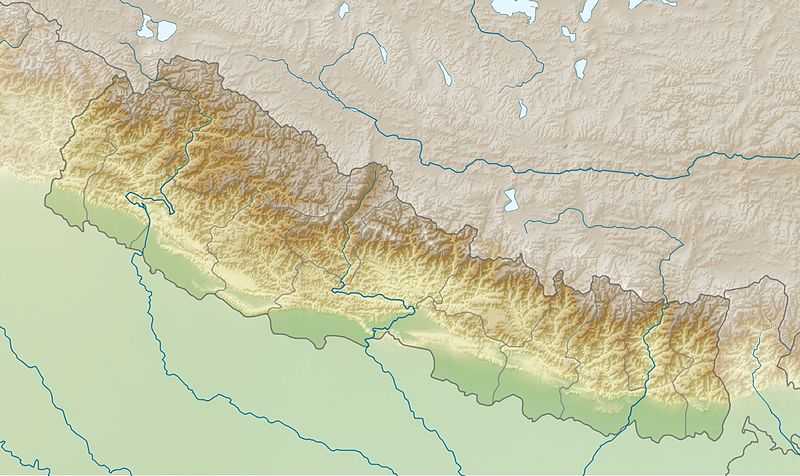Himalchuli
| Himalchuli | |
|---|---|
 Himalchuli from south | |
| Elevation |
7,893 m (25,896 ft)[1] Ranked 18th |
| Prominence | 1,633 m (5,358 ft)[1] |
| Listing | Ultra |
| Location | |
 Himalchuli Location in Nepal | |
| Location | Gandaki Zone, Nepal |
| Range | Mansiri Himal, Himalayas |
| Coordinates | 28°26′03″N 84°38′15″E / 28.43417°N 84.63750°ECoordinates: 28°26′03″N 84°38′15″E / 28.43417°N 84.63750°E[1] |
| Climbing | |
| First ascent | 1960 by Hisashi Tanabe, Masahiro Harada |
| Easiest route | glacier/snow/ice climb |
Himalchuli is the second highest mountain in the Mansiri Himal, part of the Nepalese Himalayas. It lies south of Manaslu, one of the Eight-thousanders. Himalchuli has three main peaks: East (7893 m), West (7540 m) and North (7371 m). It is also often written as two words, "Himal Chuli".
Himalchuli is the 18th highest mountain in the world (using a cutoff of 500m prominence, or re-ascent). Himalchuli is also notable for its large vertical relief over local terrain. For example, it rises 7000m over the Marsyangdi River to the southwest in about 27 km (17 mi) horizontal distance.
Climbing history
Exploratory visits to the peak were made in 1950 and 1954, and a first attempt in 1955 failed early on. Further reconnaissance and attempts followed in 1958 and 1959.
The first ascent was made in 1960, by Hisashi Tanabe and Masahiro Harada, of Japan. The route followed the "Sickle Ridge" from the southwest. They first climbed to the saddle between the West and Main peaks, where they placed the last of six camps. This ascent was somewhat unusual for a sub-8000m peak in using bottled oxygen.
The Himalayan Index lists five other ascents of this peak, and 10 additional unsuccessful attempts. The ascents were by various routes on the south, southwest, and southeast sides of the mountain.
The West Peak was first climbed in 1978 by two members of a Japanese expedition to the main peak of Himalchuli. They climbed from the south (the Dordi Khola) and approached the summit of the West Peak from the east.
The North Peak was first climbed in 1985 by a Korean expedition, via the North Face.
References
- ↑ 1.0 1.1 1.2 "High Asia II: Himalaya of Nepal, Bhutan, Sikkim and adjoining region of Tibet". Peaklist.org. Retrieved 2014-05-30.
Sources
- Neate, Jill (1990). High Asia: An Illustrated History of the 7000 Metre Peaks. Mountaineers Books. ISBN 0-89886-238-8.
- "Himalayan Index". The Alpine Club. Retrieved 2014-01-11.
- DEM files for the Himalaya (Corrected versions of SRTM data)